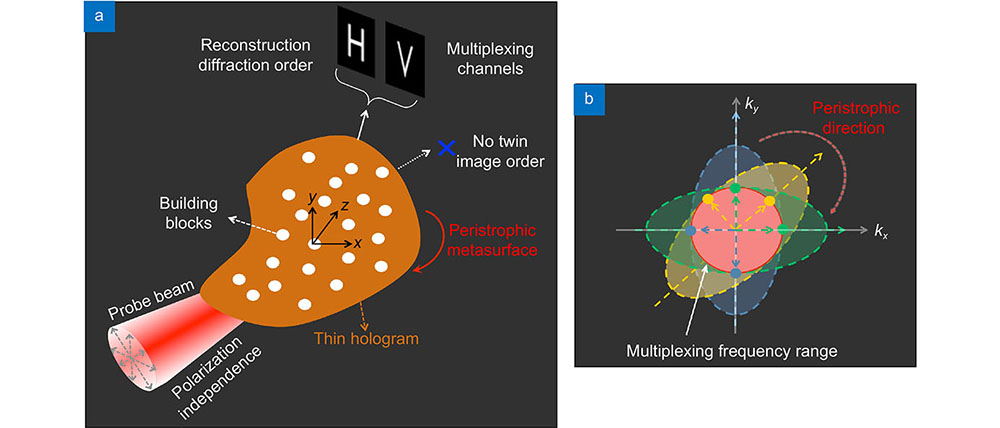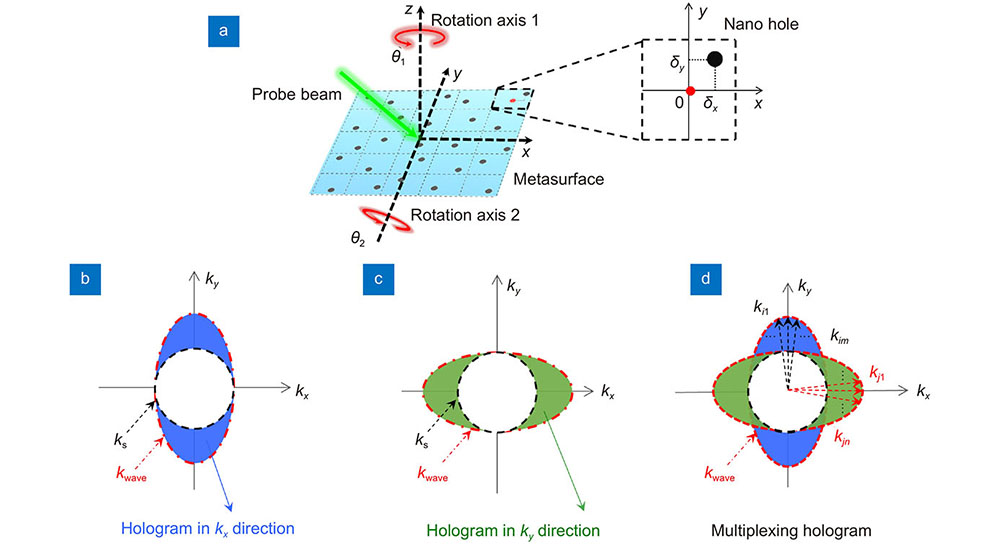Jia Chen, Dapeng Wang, Guangyuan Si, Siew Lang Teo, Qian Wang, Jiao Lin. Planar peristrophic multiplexing metasurfaces[J]. Opto-Electronic Advances, 2022, 6(8): 220141
Search by keywords or author
- Opto-Electronic Advances
- Vol. 6, Issue 8, 220141 (2022)

Fig. 1. (a ) The principle of the planar peristrophic (or rotation) multiplexed hologram. The holographic metasurface consists of a series of dislocated nanostructures and according to the relative position of adjacent building blocks, arbitrary phase modulation is attainable. When a monochromatic polarization-independent plane wave impinges on the peristrophic metasurface, the multiplexed holograms can be achieved through the spatial orthogonal directions for retrieving the images of “H” and “V” and the twin image diffraction order is blocked. (b ) The schematic diagram of the multiplexing condition during the peristrophic process. At a specific rotation angle, there is an optimized spatial frequency range that satisfies the multiplexing condition.

Fig. 2. The multiplexing rule of spatial frequency orthogonality. When an addressed incident monochromatic chromatic plane wave with vectorkwave satisfies the different threshold hologram conditions, the metasurface is viable to realize the multiplexing through the rotation along the z-axis, which means that a target hologram is encoded with one special spatial frequency of input beam and the other one is encoded with the orthogonal spatial frequency. (a ) Schematic diagram of a peristrophic multiplexed metasurface combined the spatial frequency orthogonality with the subwavelength detour phase principle. (b ) Spatial frequency multiplexing condition for the hologram in the kx direction (blue area). (c ) Spatial frequency multiplexing condition for the hologram in theky direction (green area). (d ) Orthogonal spatial frequency multiplexing relationship.
Fig. 3. Experimental setup and results of peristrophic multiplexed holograms. (a ) The far-field holographic system including a laser, a linear polarizer, a half-wave plate, two lenses (f1 =50 mm and f2 =50 mm) and a sample on a rotation stage. The holograms are captured by a CCD camera. (b ) Top-view scanning electron micrograph photos of the fabricated metasurface (scale bar: 1 µm). (c ) Calculated (based on Fourier transform) and the experimental results of the encoded “H” and “V” images. The holographic intensities are detected when the metasurface is rotated along the z-axis in different design ks.
Fig. 4. (a ) The efficiency of the targeted diffraction order as a function of different linearly polarized angles (0°, 45°, 90°, 135°, 180°). Since the power of the reconstructed images maintains consistently under different linearly polarized angles, the multiplexing method does not depend on the input polarization. (b ) The experimental results of holographic images at various polarization directions.
Fig. 5. (a ) The theoretical analyses of diffracted fields as a function of the spatial frequency and spectrum. (b ) The experimental results of multiplexing images at different wavelengths of light (λ=473 nm, 532 nm and 633 nm).

Set citation alerts for the article
Please enter your email address



